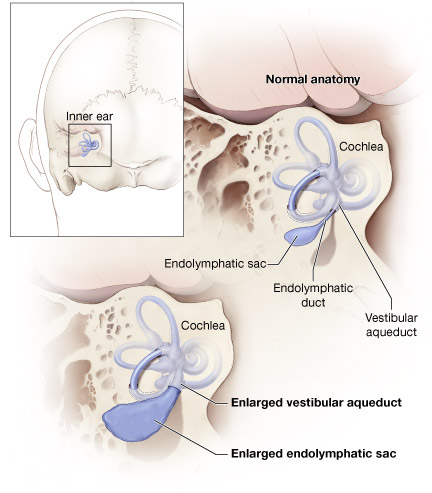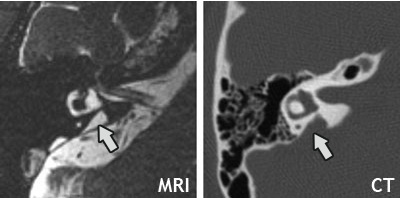On this page:
- What are vestibular aqueducts?
- How are enlarged vestibular aqueducts related to childhood hearing loss?
- How are enlarged vestibular aqueducts related to Pendred syndrome?
- What causes enlarged vestibular aqueducts?
- How are enlarged vestibular aqueducts diagnosed?
- Can enlarged vestibular aqueducts be treated to reduce hearing loss?
- What research is being conducted on enlarged vestibular aqueducts and hearing loss?
- Where can I find more information about enlarged vestibular aqueducts?
What are vestibular aqueducts?
The inner ear

Credit: NIH Medical Arts
Vestibular aqueducts are narrow, bony canals that travel from the inner ear to deep inside the skull (see figure). The aqueducts begin inside the temporal bone, the part of the skull just above the ear. The temporal bone also contains two sensory organs that are part of the inner ear. These organs are the cochlea, which detects sound waves and turns them into nerve signals, and the vestibular labyrinth, which detects movement and gravity. These organs, together with the nerves that send their signals to the brain, work to create normal hearing and balance. Running through each vestibular aqueduct is a fluid-filled tube called the endolymphatic duct, which connects the inner ear to a balloon-shaped structure called the endolymphatic sac.
Recent studies indicate that a vestibular aqueduct is abnormally enlarged if it is larger than one millimeter, roughly the size of the head of a pin. This is called an enlarged vestibular aqueduct, or EVA; the condition is also known as a dilated vestibular aqueduct or a large vestibular aqueduct. If a vestibular aqueduct is enlarged, the endolymphatic duct and sac usually grow large too. The functions of the endolymphatic duct and sac are not completely understood. Scientists believe that the endolymphatic duct and sac help to ensure that the fluid in the inner ear contains the correct amounts of certain chemicals called ions. Ions are needed to help start the nerve signals that send sound and balance information to the brain.
How are enlarged vestibular aqueducts related to childhood hearing loss?
Research suggests that most children with enlarged vestibular aqueducts (EVA) will develop some amount of hearing loss. Scientists also are finding that 5 to 15 percent of children with sensorineural hearing loss (hearing loss caused by damage to sensory cells inside the cochlea) have EVA. However, scientists do not think that EVA causes the hearing loss, but that both are caused by the same underlying defect. EVA can be an important clue pointing to what is actually causing the hearing loss.
How are enlarged vestibular aqueducts related to Pendred syndrome?
EVA can be a sign of a genetic disorder called Pendred syndrome, a cause of childhood hearing loss. According to a study by the National Institute on Deafness and Other Communication Disorders (NIDCD), approximately one-fourth of the people with EVA and hearing loss have Pendred syndrome. Hearing loss associated with Pendred syndrome is usually progressive, which means that a child will lose hearing over time. Some children may become totally deaf.
In addition to its association with hearing loss, EVA also may be linked to balance problems in a small percentage of people. However, the brain is very good at making up for a weak vestibular system, and most children and adults with EVA don't have balance disorders or difficulty doing routine tasks.
What causes enlarged vestibular aqueducts?
EVA has many causes, not all of which are fully understood. The most well-known cause of EVA and hearing loss is mutations in a gene called SLC26A4 (previously known as the PDS gene). Two mutations in the SLC26A4 gene can result in Pendred syndrome. Scientists believe that other, currently unknown, genetic or environmental factors also may lead to EVA.
How are enlarged vestibular aqueducts diagnosed?
Images of the right temporal bone of someone with EVA

Left: MRI scan showing enlargement of the endolymphatic sac
and duct (indicated by the arrow).
Right: CT scan showing enlargement of the vestibular aqueduct
(indicated by the arrow).
Medical professionals use different clues to help them determine the cause of hearing loss. Two tests that are often used to identify the cause of hearing loss are magnetic resonance imaging (MRI) and computed tomography (CT) imaging of the inner ear. One or both tests are often recommended to evaluate a child with sensorineural hearing loss. This is particularly true when a child's hearing loss occurs suddenly, is greater in one ear than the other, or varies or gets worse over time. Although most CT scans of children with hearing loss are normal, EVA is the most commonly observed abnormality.
Can enlarged vestibular aqueducts be treated to reduce hearing loss?
No treatment has proven effective in reducing the hearing loss associated with EVA or in slowing its progression. Although some otolaryngologists (a doctor or surgeon who specializes in diseases of the ears, nose, throat, and head and neck) recommend steroids to treat sudden sensorineural hearing loss, there are no scientific studies to show that this is an effective treatment for EVA. In addition, surgery to drain liquid out of the endolymphatic duct and sac or to remove the endolymphatic duct and sac is not only ineffective in treating EVA, it can be harmful. Research has shown conclusively that these surgeries can destroy hearing.
To reduce the likelihood of progression of hearing loss, people with EVA should avoid contact sports that might lead to head injury; wear head protection when engaged in activities such as bicycle riding or skiing that might lead to head injury; and avoid situations that can lead to barotrauma (extreme, rapid changes in air pressure), such as scuba diving or hyperbaric oxygen treatment. The pressure changes associated with flying in airplanes have also been reported to cause hearing loss in people with EVA. However, this is a rare event in commercial aircraft with pressurized cabins. If you have EVA, you can minimize your risk of hearing loss associated with air travel by taking nasal decongestants if you have sinus or nasal congestion, such as during a cold or flu.
Identifying hearing loss as early as possible is the best way to reduce EVA's impact. The earlier hearing loss is identified in children, the sooner they can develop skills that will help them learn and communicate with others. Children with permanent and progressive hearing loss, which is often linked with EVA, will benefit from learning other forms of communication, such as sign language or cued speech, or using assistive devices, such as a hearing aid or cochlear implant.
What research is being conducted on enlarged vestibular aqueducts and hearing loss?
While mutations in the SLC26A4 gene are known to cause EVA, not all EVA cases are the result of an SLC26A4 mutation. Some cases may be caused by other genetic or environmental factors. For these reasons, NIDCD researchers are currently conducting a clinical study to identify and understand the various factors that can lead to EVA and hearing loss. More information on this study is available here.
Where can I find more information about enlarged vestibular aqueducts?
The NIDCD maintains a directory of organizations that provide information on the normal and disordered processes of hearing, balance, taste, smell, voice, speech, and language.
For more information, contact us at:
NIDCD Information Clearinghouse
1 Communication Avenue
Bethesda, MD 20892-3456
Toll-free voice: (800) 241-1044
Toll-free TTY: (800) 241-1055
Email: nidcdinfo@nidcd.nih.gov
NIH Pub. No. 06-6053
Updated November 2012
*Note: PDF files require a viewer such as the free Adobe Reader.

